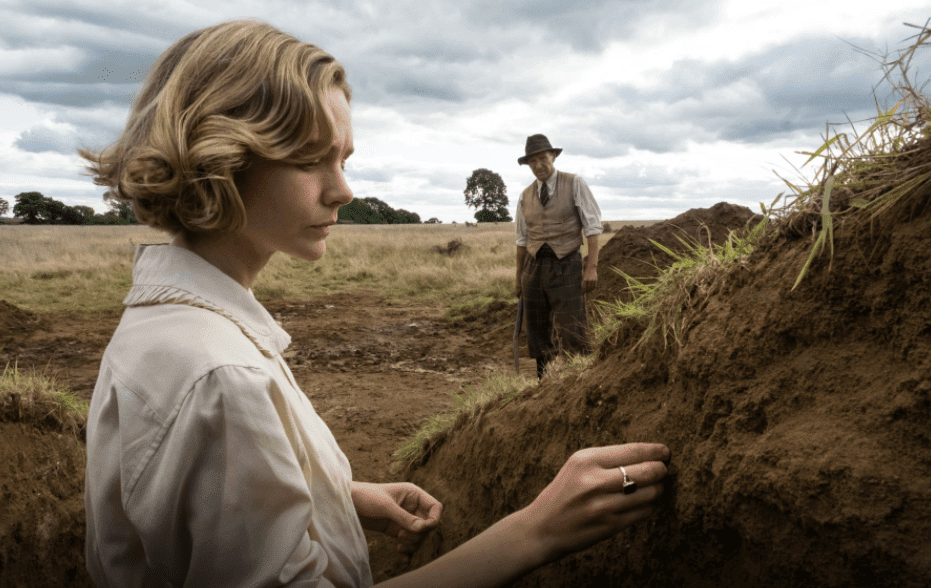
Netflix’s The Dig, to put it bluntly, feels like Oscar bait. Adapted from a novel by John Preston that fictionalizes the 1939 discovery of the Sutton Hoo Anglo-Saxon burial sites, it stars Carey Mulligan as Edith Pretty, an ailing aristocrat who commissions archeologist Basil Brown (Ralph Fiennes) to excavate some land on her property. Though war looms in the distance and the interpersonal dramas amongst the film’s large (and stacked) cast of characters could fill multiple movies, The Dig really cares about the excavation above all else, possibly to its detriment.
Even from the film’s opening shots, director Simon Stone constantly makes it clear that these characters are less important than the history surrounding them. Cinematographer Mike Eley’s images are expansive, often shot low and wide, and while that visual style emphasizes the land and the rich history it holds, it also has the unfortunate side effect of leaving the whole film feeling a little remote from the characters’ emotions. Perhaps the most egregious example comes when Pretty learns that her chronic illness will likely lead to her premature death. The camera sits outside the window of her doctor’s office as she receives the news, but rather than push in to feature Mulligan’s acting skill, the camera pulls back so that we can watch Pretty walk out of the office a few moments later. It’s a beautiful shot, certainly, but it keeps the viewer from feeling the weight of that moment and that kind of disconnect happens over and over again throughout—and not just on a visual level.
Though The Dig is technically adapted from a fictionalized version of history, the ways it differs from real life stick out. Despite the film’s general restraint, it becomes fairly obvious in the first act that there’s a chemistry between Brown and Pretty. Given the over 20-year age difference between Mulligan and Fiennes, it’s initially easy to dismiss that chemistry as just mutual respect—two people who were never allowed to realize their ambitions recognizing each other’s loneliness and drive. However, when Brown’s wife’s unexpected visit thwarts a dinner Brown and Pretty are meant to share, it becomes clear that some sort of romance was brewing between them.
That in and of itself wouldn’t be so ridiculous. Mulligan and Fiennes are great actors and the way they quietly but firmly establish their characters’ connection could easily overcome any discomfort with their age difference. The problem comes when you compare the actors to their real-life counterparts. In truth, Pretty was not only much closer in age to Brown, but a few years older than him. Mulligan is in her mid-thirties playing a woman who would have been in her mid-fifties when the story takes place and that casting choice not only alters the way Pretty and Brown’s relationship plays, but how that character functions within the whole film. The deference and confidence that would have naturally come with her age here becomes the preternatural strength of a woman well beyond her years. Her life-threatening illness is elevated from somewhat unfortunately early to tragically young.
Perhaps if the film were more focused on the characters’ arcs, choices like this would grate far more than they do, but pretty much every plot both major and minor feels secondary to the drama of who will excavate the find and who will ultimately get credit. Even situations that are inherently more dramatic than Pretty and Brown’s unrealized attraction–like Peggy’s (Lily James) slow realization that her husband is gay and her growing attraction to Rory (Johnny Flynn)–happen with very little hurt feelings or difficulty. Even the accidental crash and subsequent death of an RAF pilot in a river not far from the dig, shocking as it may be, feels like a reminder that a war is coming and soon enough nobody will care about the excavation drama.
Indeed, every character-driven plot point is presented so dispassionately that it would be easy to watch The Dig and dismiss it by saying nothing really happens. Pretty tells Brown to dig, he discovers an invaluable piece of history and a large ensemble of character spend much of the movie arguing about who gets credit for the find—all while a bunch of petty personal dramas play at the fringes. However, it’s precisely the film’s wide scope and soft touch that allow it to explore what it means to feel the weight of history on our everyday lives.
When Rory asks Peggy on a late-night stroll what would be left of the two of them if time were to suddenly flash forward a thousand years, there’s certainly something tragic in the her response that his watch and lighter would likely be all that remained, but it also emphasizes the importance of their moments together. Their attraction and all the other dramas that surround them are the vital parts of life that motivate everything but so rarely make it into the official record. The Dig may not get every detail right and it may not even be that interested in details at all. But there’s something poignant in the way it tries to capture this delicate moment of discovery poised one the edge of an event that changes the world. Its success isn’t necessarily in dramatizing this single story, but collapsing thousands of years of human experience upon each other to remind us of life’s inherent beauty.

